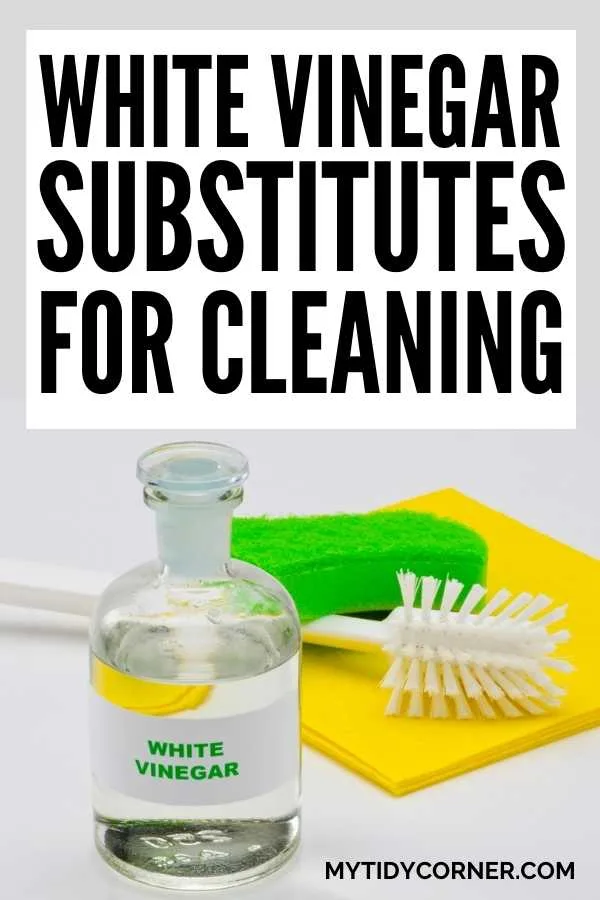White Vinegar Substitutes for Cleaning You May Already Have at Home
Discover what to use instead of white vinegar for cleaning. These substitutes for white vinegar are not only effective, but are also safe to use since they do not contain harmful chemicals.
White vinegar is often used to replace harsh detergents with possibly harmful chemicals. While this may be your go-to for cleaning, there are bound to be times you simply do not have this handy substance on hand. When you find yourself without white vinegar, what can you use instead?
Alternative vinegar types include apple cider, cleaning, and balsamic vinegar. For a similar effect, you can also use baking soda, diluted dish soap, or hydrogen peroxide. White vinegar contains acetic acid. This acid works to combat grime and acts as a mild sanitizer.

Related Cleaning Articles:
- Cleaning with Vinegar – Simple Tips and Tricks
- Vinegar to Water Ratio for Cleaning
- Can I Use Vinegar on Granite Countertops?
Many of us love to use white vinegar as a cleaning agent. It works well, sanitizes as it goes, and is not as harsh as some commercially available detergents. Little wonder, it is seen by many as the best vinegar for cleaning.
When you are accustomed to using white vinegar for cleaning, it can be disconcerting to be left stranded without your favorite natural cleaner. Luckily, there are several white vinegar alternatives you may have in your home. If not, they are sure to be easy to find in a store near you.
For those times when you have simply run out of white vinegar, we bring you a few vinegar alternatives to use instead of white vinegar for cleaning.
What Makes White Vinegar a Good Cleaning Agent?
When we consider the best alternatives for white vinegar when cleaning, it is best to determine what makes white vinegar an excellent option, to begin with.
White vinegar is, in fact, one of the only types of vinegar that are made in a factory rather than by natural means. While balsamic vinegar is made with grapes from the South of Italy, apple cider vinegar is made using apples, and white vinegar is made with synthetically created acetic acid and water.
Vinegar is so acidic because it undergoes a double fermentation process. First, the sugar becomes alcohol. After that, it changes into acetic acid.
Regarding cleaning, white vinegar is excellent since it has a pH of 24. This relatively strong acid can fight grime and grease and rid fabric of dirt, from sweat to grass stains.
Vinegar is excellent for cleaning mirrors, windows, wooden surfaces, tiles, sinks, couches, and clothes. Be wary of using it on delicate fabrics and granite, however. The high acid levels of vinegar can damage items like this.
What Can I Use Instead of White Vinegar for Cleaning?
Knowing why vinegar is an excellent choice for cleaning makes choosing the right possible alternatives easier.
Substitutes for white vinegar should be non toxic (without harsh chemicals) and effective at getting rid of dirt. These two factors should ensure your home gets cleaned while keeping you, your family, and the planet safe.
A few alternative types of vinegar you could use for cleaning include:
- Cleaning vinegar
- Apple cider vinegar
- Balsamic vinegar
- Rice vinegar
Put on your cleaning gloves. We are about to learn more about each of these.
Cleaning Vinegar
Cleaning vinegar is a vinegar made specifically for cleaning, not adding to food. Like white vinegar, it is made from corn or grains and is distilled to form alcohol, then acid.
Cleaning vinegar has about six percent acid, slightly higher than white vinegar, which has about five percent. It should not be confused with industrial vinegar, however. Industrial vinegar has around twenty percent acid and is too potent to use for home cleaning.
Consider wearing gloves to protect your skin when using cleaning vinegar at home. It can be mixed with other soaps but should never be mixed with bleach.
The acid in vinegar mixed with the chlorine found in many types of bleach creates a harmful chemical called chloric acid. The fumes from this acid can cause severe damage to your body in the long and the short term.
To clean floors with cleaning vinegar, mix half a cup with a gallon of lukewarm water. Use a mop, sponge, or old cloth to clean the floor or other surface that needs intervention.
Several surfaces can be cleaned using cleaning vinegar. These include:
- Glass
- Laminate flooring
- Bathroom tiles
- Hardwood floors
- Plumbing (vinegar works well to unblock drains)
- Coffee makers
- Microwaves
Although cleaning vinegar is a mighty weapon in the war against grime, there are a few surfaces that should not be exposed to it or any vinegar. These include:
- Granite or any porous surface
- Electronic devices
- Stainless steel
- Waxed or unfinished wood
- Cast iron
- Rubber or plastic
Apple Cider Vinegar
Apple cider vinegar is light brown and can also be used for cleaning. It is similar to white vinegar and has a slightly better smell. Although typically somewhat more expensive than white vinegar, it is a viable option and available in most stores.
Apple cider vinegar is made by covering apples with water and leaving them at room temperature. The first part of the fermentation process is when the apple’s natural sugars become alcohol. After that, bacteria break down the alcohol to make acetic acid.
It is best to use apple cider vinegar diluted in water. You can use equal parts water and vinegar to spray or wipe on surfaces.
Note that apple cider vinegar is brown in color, so you should not use it to clean light surfaces or in doing laundry.
This type of vinegar is also handy for a few other problem areas in the home, including:
- Hard water stains
- Blocked drains
- Mildew
Hard Water Stains
To clean hard water stains using apple cider vinegar, do not dilute it. Instead, let it soak on a rag on top of the marks or directly on the surface for at least an hour.
Rinse the area after the allotted time, and the stains should be gone.
Blocked Drains
To unblock drains using apple cider vinegar, it is best to use it neat and with baking soda.
Place around half a cup of baking soda down the blocked drain. Next, add around a quarter cup of apple cider vinegar to the mix.
Allow the solution to get to work for at least fifteen minutes, then douse with hot water to rinse the drain-blocking grime away.
Mildew
Mildew is a common problem in homes, especially where there is moisture or a problem with damp walls or floors.
Apple cider vinegar can work as effectively as bleach if used correctly, and it is safer for you and your family.
To clean away mildew using apple cider vinegar, use a concentrate directly onto the surface. You may wish to use an earbud or old toothbrush to get into small spaces.
Leave the vinegar on the mildew for around thirty minutes, then wipe the vinegar and mold away.
To maintain areas that typically have mildew build-up, consider diluting apple cider vinegar with water and applying it with a cloth or spray bottle as part of your cleaning routine.
Balsamic Vinegar
Balsamic vinegar is made using grapes. It originates from the South of Italy. It is usually a lot more expensive than other kinds of vinegar, and the dark color means that it is not always the best choice for cleaning.
Still, if you are in a pickle, balsamic vinegar has a similar pH to white vinegar, so it will clean away dirt and grime.
Balsamic is likely not your best option if you are looking for a type of vinegar to use consistently. The dark colors result from the grapes used to create it and will stain light-colored fabrics and surfaces in your home.
Rice Vinegar
Rice vinegar is made using rice, the same way white vinegar and apple cider vinegar are. The rice is distilled and fermented to create alcohol and then vinegar. It can be red, dark brown, black, or pale yellow.
You can definitely use rice vinegar instead of white vinegar for cleaning; however, it is not as effective since the pH level of this vinegar is lower than that of white vinegar.
Another issue with using rice vinegar for cleaning is that it leaves a residue. White vinegar does not typically leave a residue, so it is a better cleaning agent.
While white vinegar is more readily available in North America and Europe, rice vinegar is more prevalent in Asia.
Other Alternatives to White Vinegar for Cleaning
Other white vinegar alternatives for cleaning include:
- Baking Soda
- Dish Soap
- Hydrogen Peroxide
Final Thoughts on What to Use Instead of White Vinegar for Cleaning
White vinegar is a great cleaner that can go a long way in combating the dirt that often finds its way into our homes. Consider trying another type of vinegar when you are all out of white vinegar.
Your best option is likely cleaning vinegar, although apple cider vinegar works well too. Rice vinegar tends to leave residue after cleaning, and balsamic, although good at working through grime, is dark in color and leaves a stain after cleaning.
I hope you found our list of what to use instead of white vinegar for cleaning helpful? Leave your comment below.

